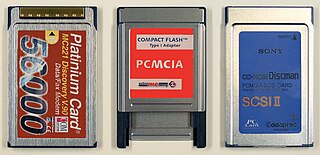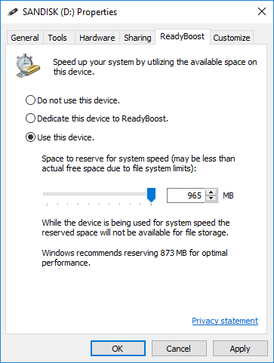Related Research Articles

Universal Serial Bus (USB) is an industry standard that allows data exchange and delivery of power between many various types of electronics. It specifies its architecture, in particular its physical interface, and communication protocols for data transfer and power delivery to and from hosts, such as personal computers, to and from peripheral devices, e.g. displays, keyboards, and mass storage devices, and to and from intermediate hubs, which multiply the number of a host's ports.

PC Card is a parallel peripheral interface for laptop computers and PDAs.

Western Digital Corporation is an American computer drive manufacturer and data storage company, headquartered in San Jose, California. It designs, manufactures and sells data technology products, including data storage devices, data center systems and cloud storage services.

A live CD is a complete bootable computer installation including operating system which runs directly from a CD-ROM or similar storage device into a computer's memory, rather than loading from a hard disk drive. A live CD allows users to run an operating system for any purpose without installing it or making any changes to the computer's configuration. Live CDs can run on a computer without secondary storage, such as a hard disk drive, or with a corrupted hard disk drive or file system, allowing data recovery.
In computing, a removable media is a data storage media that is designed to be readily inserted and removed from a system. Most early removable media, such as floppy disks and optical discs, require a dedicated read/write device to be installed in the computer, while others, such as USB flash drives, are plug-and-play with all the hardware required to read them built into the device, so only need a driver software to be installed in order to communicate with the device. Some removable media readers/drives are integrated into the computer case, while others are standalone devices that need to be additionally installed or connected.

A USB flash drive is a data storage device that includes flash memory with an integrated USB interface. A typical USB drive is removable, rewritable, and smaller than an optical disc, and usually weighs less than 30 g (1 oz). Since first offered for sale in late 2000, the storage capacities of USB drives range from 8 to 256 gigabytes (GB), 512 GB and 1 terabyte (TB). As of 2023, 2 TB flash drives were the largest currently in production. Some allow up to 100,000 write/erase cycles, depending on the exact type of memory chip used, and are thought to physically last between 10 and 100 years under normal circumstances.

A home theater PC (HTPC) or media center computer is a convergent device that combines some or all the capabilities of a personal computer with a software application that focuses on video, photo, audio playback, and sometimes video recording functionality. Since the mid-2000s, other types of consumer electronics, including game consoles and dedicated media devices, have crossed over to manage video and music content. The term "media center" also refers to specialized application software designed to run on standard personal computers.
The Freebox is an ADSL-VDSL-FTTH modem and a set-top box that the French Internet service provider named Free provides to its DSL-FTTH subscribers.

The USB mass storage device class is a set of computing communications protocols, specifically a USB Device Class, defined by the USB Implementers Forum that makes a USB device accessible to a host computing device and enables file transfers between the host and the USB device. To a host, the USB device acts as an external hard drive; the protocol set interfaces with a number of storage devices.

A portable media player (PMP) or digital audio player (DAP) is a portable consumer electronics device capable of storing and playing digital media such as audio, images, and video files. The data is typically stored on a compact disc (CD), Digital Versatile Disc (DVD), Blu-ray Disc (BD), flash memory, microdrive, SD cards or hard drive; most earlier PMPs used physical media, but modern players mostly use flash memory. In contrast, analogue portable audio players play music from non-digital media that use analogue media, such as cassette tapes or vinyl records.
In computing, external storage refers to non-volatile (secondary) data storage outside a computer's own internal hardware, and thus can be readily disconnected and accessed elsewhere. Such storage devices may refer to removable media, compact flash drives, portable storage devices, or network-attached storage. Web-based cloud storage is the latest technology for external storage.

ReadyBoost is a disk caching software component developed by Microsoft for Windows Vista and included in later versions of Windows. ReadyBoost enables NAND memory mass storage CompactFlash, SD card, and USB flash drive devices to be used as a cache between the hard drive and random access memory in an effort to increase computing performance. ReadyBoost relies on the SuperFetch and also adjusts its cache based on user activity. ReadyDrive for hybrid drives is implemented in a manner similar to ReadyBoost.

My Book is a series of external hard drives produced by Western Digital. There are currently nine series of My Book drives: Essential Edition, Home Edition, Office Edition, Mirror Edition, Studio Edition, Premium Edition, Elite Edition, Pro Edition, AV Dvr "Live Edition", and the World Edition.

A digital media player is a type of consumer electronics device designed for the storage, playback, or viewing of digital media content. They are typically designed to be integrated into a home cinema configuration, and attached to a television or AV receiver or both.

M-Systems Ltd., was a Nasdaq-listed Israeli producer of flash memory storage products founded in 1989 by Dov Moran and Aryeh Mergi, based in Kfar Saba, Israel. They were best known for developing and patenting the first flash drive, marketed in 1995 as DiskOnChip, and the first USB flash drive, marketed in 2000 as DiskOnKey. They also created the patented True Flash Filing System (TrueFFS) which presented the flash memory as a disk drive to the computer. After 17 years of business, they were acquired by their prior competitor, SanDisk, in 2006. The DiskOnChip (DOC) was developed at the R&D Center established by M-Systems called EUROM. Rick Iorillo, Rony Levy and David Deitcher were the individuals that worked on the development and marketing of the first 2 MB DOC. This product went on to receive the Most Innovative Award from EDN in 1995 and later went on to become the Flash Drive and DiskOnKey.

The SheevaPlug is a "plug computer" designed to allow standard computing features in as small a space as possible. It was a small embedded Linux ARM computer without a display which can be considered an early predecessor to the subsequent Raspberry Pi.
The WD TV is a consumer device that was produced by Western Digital which plays videos, images, and music from USB drives or network locations. The device was introduced in 2008 and played high-definition video through an HDMI port, and standard video through composite video cables. The device had support for most common video and audio formats. The WD TV was discontinued as of August 2016.
A USB image — is bootable image of Operating system (OS) or other software where the boot loader is located on a USB flash drive, or another USB device instead of conventional CD or DVD discs. The operating system loads from the USB device either to load it much like a Live CD that runs OS or any other software from the storage or installs OS itself. USB image runs off of the USB device the whole time. A USB image is easier to carry, can be stored more safely than a conventional CD or DVD. Drawbacks are that some older devices may not support USB booting and that the USB storage devices lifespan might be shortened.
Dmailer was a French company which specialized in portable backup and synchronization software for devices, including USB flash drives, memory cards, external hard disk drives, MP3 players, embedded phone memories, SIM cards and flash-based memory cards for mobile phones.
References
- Farrance, R. (2004). Storage options merge into one box. Retrieved January 14, 2003 from http://www.pcworld.com/news/article/0,aid,114272,tk,dn011304X,00.asp
- http://news.cnet.com/8301-13506_3-20020790-17.html?tag=mncol;6n
